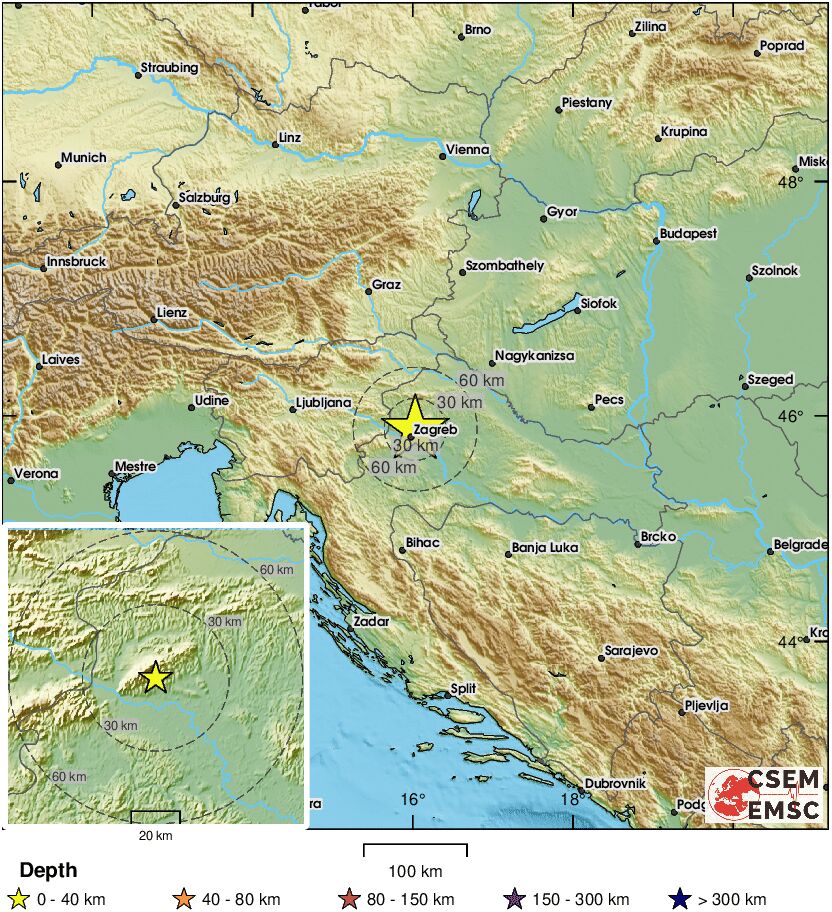March the 11th, 2024 – Well known Croatian seismologist Hrvoje Tkalčić, who wrote a popular book on earthquakes not so long ago, recently took to Facebook to discuss the latest Zagreb earthquakes.
As Poslovni Dnevnik writes, seismologist Hrvoje Tkalčić let his social media followers into a slightly more detailed analysis of the recent mild Zagreb earthquakes, which he says was felt by people in the narrower epicentral area.
“The sensation is heightened when earthquakes occur at night, when the typical city sounds are much less due to reduced human activity. That’s when the sound of some earthquakes that can spread through the air from the solid earth comes to the fore,” explained Tkalčić.
An earthquake emits energy that manifests itself in the form of seismic waves of various frequencies. In other words, soil particles oscillate a different number of times per second during the passage of the waves. For example, if the number of oscillations is 10 per second, we refer to it as having a frequency of 10 Hertz. The longitudinal part of the energy of these waves continues its way through the air as sound, and the human ear can pick it up, especially when it comes to those of several tens of Hertz, which is at the lower limit of the definition of audibility. If you heard an explosion, rumble or thunder, that’s the same thing,” he noted.
Smaller earthquakes aren’t necessarily a sign of a larger one approaching
In addition to the main fault lines, there are also a number of smaller fault lines, which are referred to by one name – a fault system, or in this case, the epicentral area. Those of us living in Zagreb and who remember the horrendous sound and feeling of the March 2020 earthquake can breathe a sigh of relief as seismologist Hrvoje Tkalčić says these smaller tremors don’t mean a big quake is on its way.
“Unfortunately, we don’t have underground maps of these fault lines in high resolution. If we had, we might be able to see how the fault lines spatially extend into the depths, how many there actually are, how they’re intertwined, and what the current state of tension in the ground due to tectonic forces is. The indeterminacy in locating earthquakes is usually such that it’s difficult for anyone to say which fault line any given earthquake occurred along with much accuracy.
Although it isn’t pleasant, the fact that the tension that continuously collects in the rock is released in the form of smaller earthquakes and therefore doesn’t accumulate into larger ones for a longer period of time in a place is comforting.
In any case, these smaller earthquakes aren’t necessarily harbingers of a larger earthquake: there’s no evidence of such a thing from any previous studies. It’s worth noting that in southern Dalmatia and elsewhere in the world, there’s more pronounced seismic activity than there is in the general Zagreb area.
When detecting earthquakes from records of seismic waves (seismograms), it’s usually a frequency range from below ten to fifteen Hertz, and only sometimes up to and even above 20 Hertz. When these seismic waves propagate through the Earth’s interior, there’s a phenomenon of wave energy weakening (attenuation) due to scattering from heterogeneity, and due to the atomic structure of the rock. This means that the highest frequency waves are the first to weaken. And while waves of lower frequencies (longer wavelengths) “survive” much longer distances along their way, those of higher frequencies disappear after they get a few kilometres away from the focal point.
However, when the focus of the earthquake is close to the Earth’s surface, as is the case for most Zagreb earthquakes (those which occur in the Markuševec epicentral area) and are so-called shallow earthquakes, waves of frequencies of about 20 Hertz and higher occur due to their relatively short path to the Earth’s surface.









